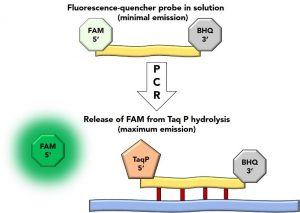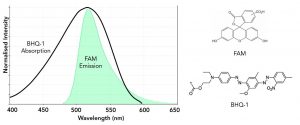COVID-19 Disease Testing; Utilising Fluorescence During a Pandemic
While the world continues to endure loss and hardship due to the outbreak of COVID-19, caused by a novel severe acute respiratory syndrome coronavirus 2 (SARS-CoV-2), researchers are scrambling to provide test kits that are accurate, fast, sensitive, and widely available, especially as symptoms vary broadly and may not appear for days if at all. To this end, several diagnostic methods have been designed and tested, and one USA FDA approved test kit utilises fluorescence based reverse transcript real-time polymerase chain reaction (rRT-PCR) technique. The rRT-PCR test works by detecting replicated nucleic acid copies from the SARS-CoV-2 virus through a bound fluorescence probe that is released from its quencher counterpart upon primer replication (Figure 1).

Figure 1. The rRT-PCR fluorescence generating process utilising a bound fluorescence and quencher pair of molecules as the probe for specific types of cDNA.
Once an appropriate specimen is taken from an individual’s respiratory system, the RNA is isolated and reverse transcribed into complementary DNA (cDNA), which then undergoes the PCR process to amplify the number of cDNA copies, with several sets of SARS-CoV-2 primer and probe detection targets. Incorporated into the probe detection sets are a pair of molecules that are bound in tandem as a fluorescence emitter and dark quencher (non-emissive); 5(6)-carboxyfluorescein (FAM) as the emitter, and Black Hole Quencher – 1 (BHQ1) as the dark quencher (Figure 2). When the PCR cycle reaches the extension phase, the Taq polymerase primer nuclease activity on the 5’ end ruptures the FAM from the BHQ-1 in the probe and its fluorescence is then measured as a function of each cycle, increasing in intensity for positive diagnoses.

Figure 2. FAM emission spectrum overlaid with the BHQ-1 absorption spectrum with their associated structures. Data obtained from BioSeach Technologies and AAT Bioquest. Molecular structures are from Sigma Aldrich (FAM) and ATDBio, Ltd. (BHQ-1).
While RT-PCR test kits and molecular probes have become more available in recent years, these molecules took creative minds and time to synthesise and optimise their photophysical properties. Furthermore, development of new molecules that are brighter, have more distinct emissions, have targeted specificity, or absorb the spectrum more broadly will undoubtedly become highly useful for a wide range of virus and disease detection. FAM has a relatively high quantum yield when excited using a 488 nm argon ion laser and in certain solvents and buffers, however, it does not work well for most other common lasers or compact laser diodes or in acidic media. Further, the peak emission of approximately 520 nm is not optimum for ultra-sensitive detectors, with Si-photodiodes peaking further into the near-infrared (NIR) around 800 – 900 nm, photomultiplier tubes (PMTs) peaking further towards the ultra-violet (UV) around 400 nm. This beseeches the need for chemists and biologists to continue developing new generations of fluorescence and quenching probes, especially ones that require fewer cycles of PCR to be detected for more rapid screening.
COVID-19 Testing Instrumentation
Edinburgh Instruments provides the most sensitive fluorescence, phosphorescence, and luminescence spectroscopy systems in the world to better facilitate researchers studying new molecular probe design. Edinburgh Instruments also has a new line of UV-Vis spectrophotometers to accurately and quickly measure a molecule’s absorption spectrum.
The FS5 is a fully integrated, purpose-built spectrofluorometer. Suited for analytical and research laboratories, the FS5 can handle the speed of routine analysis and the sensitivity of demanding research requirements. Comprehensive Fluoracle® software allows for astonishing ease of use and the design concept enables maximum flexibility, with multiple measurement modes all in one instrument.
Primarily serving material sciences, our instruments are also used in biophysics and some life science fields. Our first FS5 Spectrometer purchased specifically to investigate potential vaccines for the SARS-CoV-2 virus is due to ship in the coming weeks.
Get in Touch
If you are working within COVID-19 research and would like further information on how our instrumentation may be able to assist you, please contact our team of scientists and sales representatives for more information, technical details, or system specifications – we are standing by ready for all your molecular spectroscopy needs.
From our families to yours, we wish you all health and safety during this time, and look forward to seeing everyone again soon.








